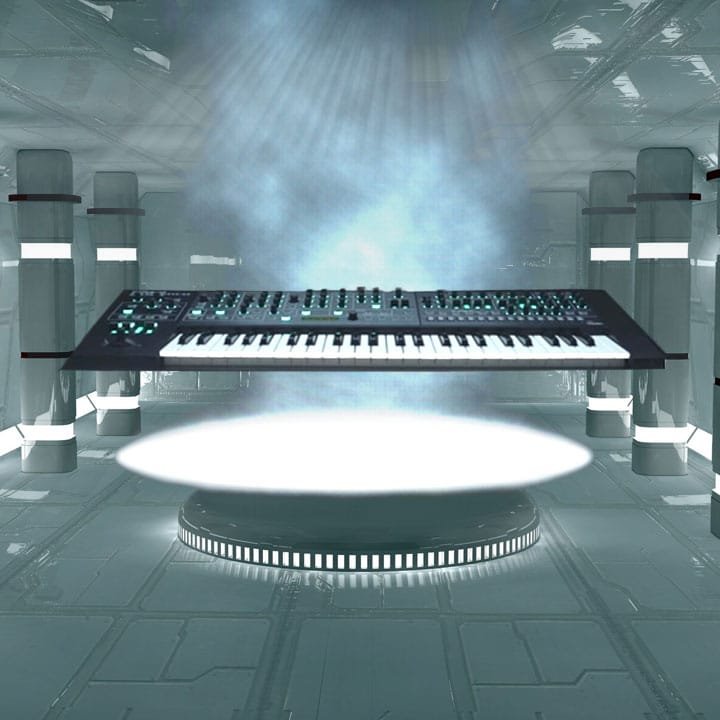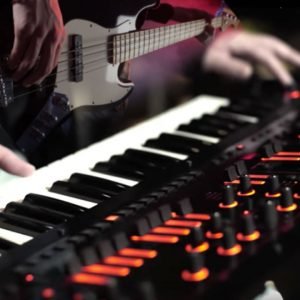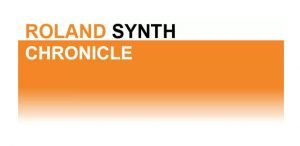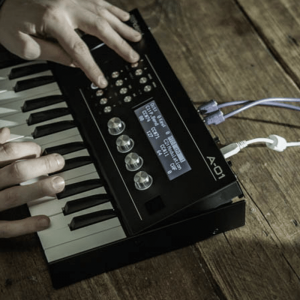Synthesizers and science fiction seem made for each other. Strange alien noises, the pulse of futuristic streets, epic pad sounds representing distant planets…shaping the sounds of sci-fi films and TV shows is a job that synths excel at.
Sci-fi appears in many different formats. But sound design is a crucial element of films and TV shows. So, this article will look at how artists and composers have used synthesizers and sound design in certain sci-fi films and TV shows.
As there is much to cover in an article like this, we’ll just focus on a few specific eras and key examples, culminating with the 1980s. We’ll also look at how 1980s film soundtracks have helped to inspire the modern synthwave genre.
Contributed by Byron Struck for the Roland Australia Blog
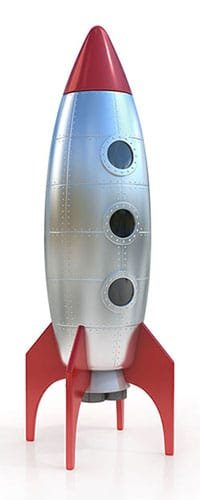 Before we dive right in though, it’s worth mentioning an example of the impact that otherworldly sci-fi sounds can have. In 1938, Orson Welles presented a radio broadcast of H.G. Wells’ alien invasion classic, The War of the Worlds.
Ora Nichols, head of the CBS radio team that created the sound effects for the performance, used items like egg beaters and cast iron lids to bring the sounds of alien invaders to life. The broadcast was so effective and the sounds were so realistic that many listeners mistook it for an actual newscast!
The first film to have a fully electronic score is the 1958 sci-fi classic, Forbidden Planet. Moving away from the traditional sci-fi and horror film sounds created by the Theremin, Bebe and Louis Barron used homemade oscillator circuits to create the sinister soundscape of the film.
Unlike anything ever heard in a motion picture before, the pioneering soundtrack of Forbidden Planet now represents the sounds we most identify with classic sci-fi, such as bleeps, whirrs and hums.
Before we dive right in though, it’s worth mentioning an example of the impact that otherworldly sci-fi sounds can have. In 1938, Orson Welles presented a radio broadcast of H.G. Wells’ alien invasion classic, The War of the Worlds.
Ora Nichols, head of the CBS radio team that created the sound effects for the performance, used items like egg beaters and cast iron lids to bring the sounds of alien invaders to life. The broadcast was so effective and the sounds were so realistic that many listeners mistook it for an actual newscast!
The first film to have a fully electronic score is the 1958 sci-fi classic, Forbidden Planet. Moving away from the traditional sci-fi and horror film sounds created by the Theremin, Bebe and Louis Barron used homemade oscillator circuits to create the sinister soundscape of the film.
Unlike anything ever heard in a motion picture before, the pioneering soundtrack of Forbidden Planet now represents the sounds we most identify with classic sci-fi, such as bleeps, whirrs and hums.
 The early 1980s was a turning point for synthesizers. Polyphonic synths like Roland’s Jupiter series gave musicians the ability to play multiple notes and chords, something the monophonic instruments of the past couldn’t do.
Digital synthesizers were also becoming more common, with affordability, new sounds and instrument emulations being appealing features. Multi track recording had developed as well. As such, a lot of synth heavy soundtracks of the 1980s used layers of sound to heighten the atmosphere, mood and tension of films.
Lush pad waves, strange sound effects, ominous sequenced pulses, electronic drums with gated reverb, brooding basslines and soaring leads helped to define the soundtracks of many 80s sci-fi films.
Almost in tandem with the evolution of synthesizers, 80s sci-fi films began to explore strange, darker new areas. Some of the most famous sci-fi films ever appeared on cinema screens, with Blade Runner, Tron, Aliens and The Terminator all becoming staples of the genre.
In TV, shows like Knight Rider, Red Dwarf, Airwolf and most notably, Miami Vice used synthesizer sounds in their intro themes and throughout their episodes. Some were sci-fi, some were not, but their music is memorable and highly synthesizer driven.
The early 1980s was a turning point for synthesizers. Polyphonic synths like Roland’s Jupiter series gave musicians the ability to play multiple notes and chords, something the monophonic instruments of the past couldn’t do.
Digital synthesizers were also becoming more common, with affordability, new sounds and instrument emulations being appealing features. Multi track recording had developed as well. As such, a lot of synth heavy soundtracks of the 1980s used layers of sound to heighten the atmosphere, mood and tension of films.
Lush pad waves, strange sound effects, ominous sequenced pulses, electronic drums with gated reverb, brooding basslines and soaring leads helped to define the soundtracks of many 80s sci-fi films.
Almost in tandem with the evolution of synthesizers, 80s sci-fi films began to explore strange, darker new areas. Some of the most famous sci-fi films ever appeared on cinema screens, with Blade Runner, Tron, Aliens and The Terminator all becoming staples of the genre.
In TV, shows like Knight Rider, Red Dwarf, Airwolf and most notably, Miami Vice used synthesizer sounds in their intro themes and throughout their episodes. Some were sci-fi, some were not, but their music is memorable and highly synthesizer driven.
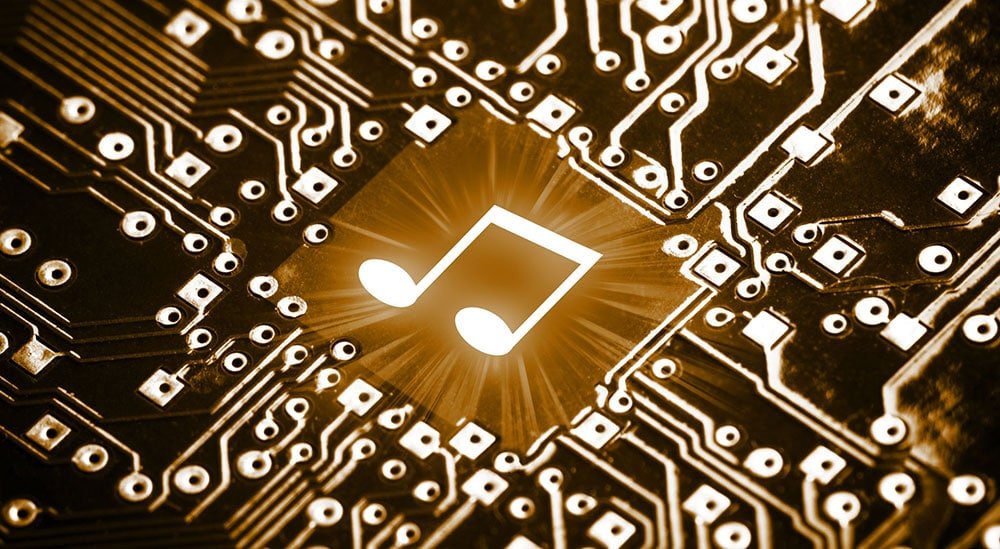 Many of the soundtracks to 80s sci-fi films have been popular and influential ever since their release. Right now, we’re witnessing a kind of resurgence in synth music of this era. Synthwave, a loosely-named genre, takes major inspiration from the films, TV shows, soundtracks and video games of the 1980s.
While 80s sci-fi films like The Terminator, Blade Runner, Robocop, Escape from New York, The Running Man and Back to the Future looked to the future during the decade of their release, in many ways, synthwave does the opposite. It looks to the past to create music with a “futuristic” sound for the 1980s, but a “retro” or nostalgic sound for today’s standards.
Using the synth and drum machine sounds of yesteryear with a strong emphasis on catchy melodies and hooks, synthwave is a broad genre but is certainly unashamed of its obvious influences.
Why synthwave is popular now is open to discussion. What is noticeable however, is that there is a tendency for a lot of synthwave to use “big” sounds. Big drum sounds, big synth layers and most notably, big reverb! Like a lot of 80s soundtracks, such as Vangelis’ Blade Runner, a lot of synthwave tends to emphasise atmospheric and epic moments.
Even artists who actually inspired today’s synthwave sounds are continuing to do so. John Carpenter, director of sci-fi classics like Escape from New York, The Thing, Starman, They Live and Dark Star has recently been recording and performing live synth music, highly reminiscent of his early film scores.
The Netflix sci-fi series Stranger Things, currently a very popular TV show, takes clear inspiration from the music and films of the 1980s. In a full-circle kind of moment, electronic music pioneers Tangerine Dream recently reworked the show’s theme song.
While synthwave certainly has a retro sound, anything created today that is inspired by the past has the benefit of a contemporary gaze. This is especially true for music technology and home recording.
Many of the soundtracks to 80s sci-fi films have been popular and influential ever since their release. Right now, we’re witnessing a kind of resurgence in synth music of this era. Synthwave, a loosely-named genre, takes major inspiration from the films, TV shows, soundtracks and video games of the 1980s.
While 80s sci-fi films like The Terminator, Blade Runner, Robocop, Escape from New York, The Running Man and Back to the Future looked to the future during the decade of their release, in many ways, synthwave does the opposite. It looks to the past to create music with a “futuristic” sound for the 1980s, but a “retro” or nostalgic sound for today’s standards.
Using the synth and drum machine sounds of yesteryear with a strong emphasis on catchy melodies and hooks, synthwave is a broad genre but is certainly unashamed of its obvious influences.
Why synthwave is popular now is open to discussion. What is noticeable however, is that there is a tendency for a lot of synthwave to use “big” sounds. Big drum sounds, big synth layers and most notably, big reverb! Like a lot of 80s soundtracks, such as Vangelis’ Blade Runner, a lot of synthwave tends to emphasise atmospheric and epic moments.
Even artists who actually inspired today’s synthwave sounds are continuing to do so. John Carpenter, director of sci-fi classics like Escape from New York, The Thing, Starman, They Live and Dark Star has recently been recording and performing live synth music, highly reminiscent of his early film scores.
The Netflix sci-fi series Stranger Things, currently a very popular TV show, takes clear inspiration from the music and films of the 1980s. In a full-circle kind of moment, electronic music pioneers Tangerine Dream recently reworked the show’s theme song.
While synthwave certainly has a retro sound, anything created today that is inspired by the past has the benefit of a contemporary gaze. This is especially true for music technology and home recording.
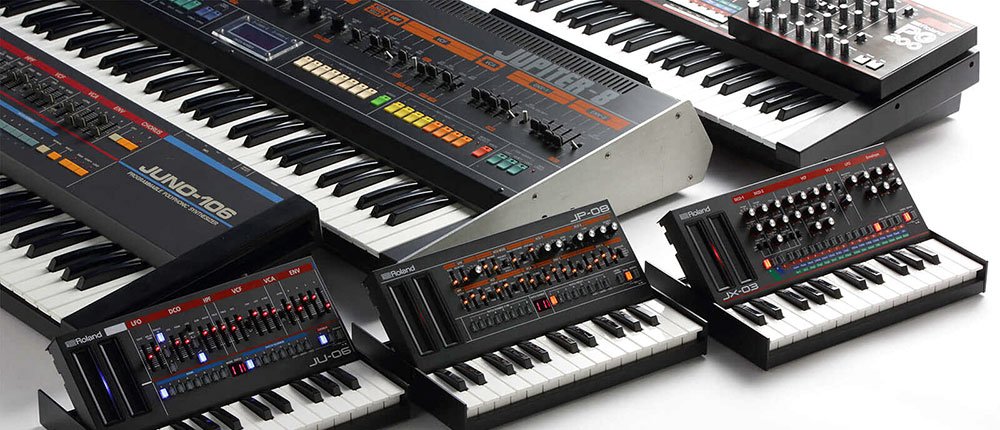 In true retro futurism style, we here at Roland have reissued some of our most legendary instruments. Among these, are our boutique range of synthesizer modules based on the Jupiter-8, the JX-3P and the Juno-106 respectively.
The Roland Jupiter-8, the Roland JX-3P and the Roland-106 synths helped to define the sound of the 1980s. They appear on countless releases, soundtracks and in films. Noted for their huge range of tonal options and rich, analog sound, these synthesizers are instantly recognisable.
In true retro futurism style, we here at Roland have reissued some of our most legendary instruments. Among these, are our boutique range of synthesizer modules based on the Jupiter-8, the JX-3P and the Juno-106 respectively.
The Roland Jupiter-8, the Roland JX-3P and the Roland-106 synths helped to define the sound of the 1980s. They appear on countless releases, soundtracks and in films. Noted for their huge range of tonal options and rich, analog sound, these synthesizers are instantly recognisable.
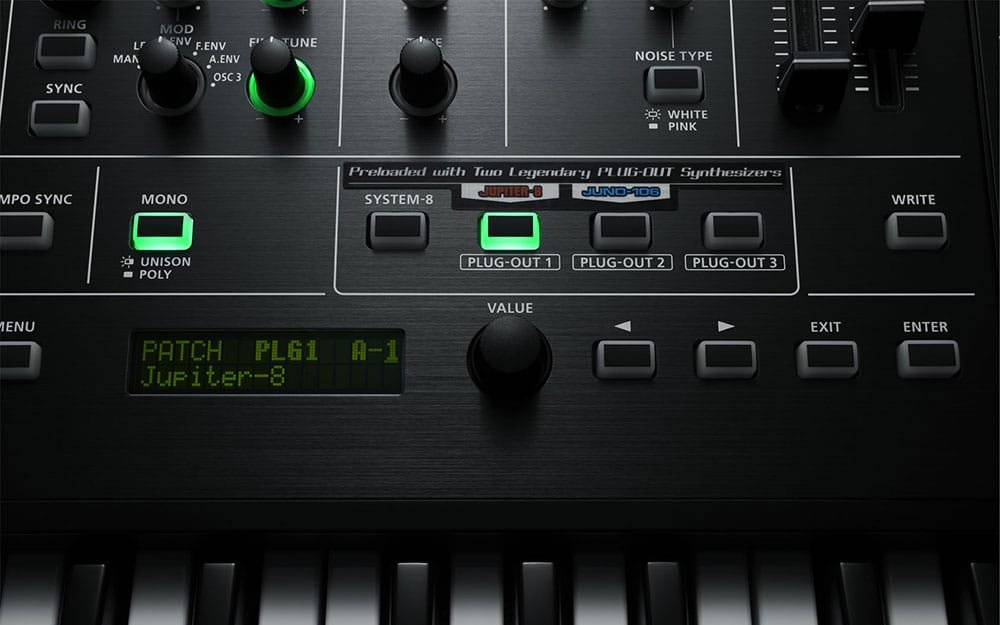 Roland synths like the Jupiter-8, Juno-106, SH101 and more are available as soft synths and are easily integrated into a Plug-Out equipped hardware synth, like the Roland System-8, via USB.
Once transferred to the external machine, the software’s signal path routes to the knobs, faders and controls of the hardware synth. This means that full tactile control of the soft synths is possible with the hardware synth and can be used anywhere, without needing a laptop or computer connection.
Roland synths like the Jupiter-8, Juno-106, SH101 and more are available as soft synths and are easily integrated into a Plug-Out equipped hardware synth, like the Roland System-8, via USB.
Once transferred to the external machine, the software’s signal path routes to the knobs, faders and controls of the hardware synth. This means that full tactile control of the soft synths is possible with the hardware synth and can be used anywhere, without needing a laptop or computer connection.
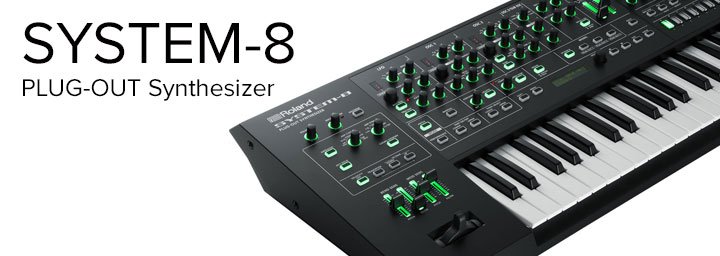
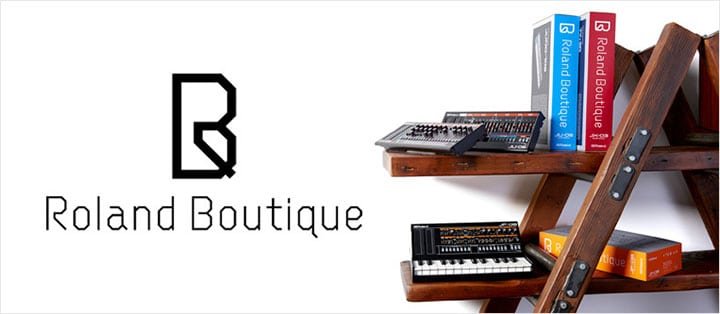
A LITTLE BIT OF HISTORY…
 Before we dive right in though, it’s worth mentioning an example of the impact that otherworldly sci-fi sounds can have. In 1938, Orson Welles presented a radio broadcast of H.G. Wells’ alien invasion classic, The War of the Worlds.
Ora Nichols, head of the CBS radio team that created the sound effects for the performance, used items like egg beaters and cast iron lids to bring the sounds of alien invaders to life. The broadcast was so effective and the sounds were so realistic that many listeners mistook it for an actual newscast!
The first film to have a fully electronic score is the 1958 sci-fi classic, Forbidden Planet. Moving away from the traditional sci-fi and horror film sounds created by the Theremin, Bebe and Louis Barron used homemade oscillator circuits to create the sinister soundscape of the film.
Unlike anything ever heard in a motion picture before, the pioneering soundtrack of Forbidden Planet now represents the sounds we most identify with classic sci-fi, such as bleeps, whirrs and hums.
Before we dive right in though, it’s worth mentioning an example of the impact that otherworldly sci-fi sounds can have. In 1938, Orson Welles presented a radio broadcast of H.G. Wells’ alien invasion classic, The War of the Worlds.
Ora Nichols, head of the CBS radio team that created the sound effects for the performance, used items like egg beaters and cast iron lids to bring the sounds of alien invaders to life. The broadcast was so effective and the sounds were so realistic that many listeners mistook it for an actual newscast!
The first film to have a fully electronic score is the 1958 sci-fi classic, Forbidden Planet. Moving away from the traditional sci-fi and horror film sounds created by the Theremin, Bebe and Louis Barron used homemade oscillator circuits to create the sinister soundscape of the film.
Unlike anything ever heard in a motion picture before, the pioneering soundtrack of Forbidden Planet now represents the sounds we most identify with classic sci-fi, such as bleeps, whirrs and hums.
THE BIRTH OF MODERN CLASSICS
Moving into the 1960s, Ron Grainer’s famous score for Dr. Who became a turning point in electronic music. In a time before commercially available synthesizers and with no studio musicians available to score a humble sci-fi series, Delia Derbyshire and Dick Mills of the BBC Radiophonic Workshop used techniques like tape splicing and looping from sound generating equipment to realise Grainer’s notes. In the process, they created the now instantly recognisable theme, which is essential to the long running series and its massive popularity. Star Trek also premiered in the 1960s. Another long running and hugely popular sci-fi franchise, the original version of the show needed a library of sounds to express the action on screen. The series’ sound designers, Douglas Grindstaff, Jack Finlay and Joseph Sorokin used a variety of methods like manipulating tape speed with effects and mixing real world sounds with recorded loops to create drama and tension. While different versions of the show have endured and audio technology has progressed with them, the original series’ sound design remains highly regarded.THE PROGRESSIVE 1970s
By the 1970s, synthesizers had developed to give composers a lot of sounds to use. Artists such as Pink Floyd, Tangerine Dream, Klaus Schulze and Jean Michel Jarre began to explore electronic music in exciting new ways. The dawn of a “Golden Age” of science fiction, the 1970s saw synthesizers and sci-fi really beginning to overlap. Wendy Carlos’ score for Stanley Kubrick’s A Clockwork Orange mirrored the bleak, dystopic vision of the film with haunting, neo-classical synth melodies. Both the film and the score went on to become landmarks in sci-fi and electronic music and showed the possibilities for electronic music in film. Avant-garde scores appeared in sci-fi films like Logan’s Run, Solaris, The Andromeda Strain, Stalker and Westworld. Many of these films used both electronic sounds with traditional orchestral instruments, played in unorthodox ways for unusual results. With the 70s of course being the era of progressive rock, the Italian prog rock band Goblin, used synthesizers for horror film soundtracks like Suspiria, creating bizarre soundscapes. A noticeable shift occurred around the late 70s/early 80s, with synthesizers becoming a more prominent instrument in film soundtracks. Probably the most telling sign of what many 80s film soundtracks (sci-fi or otherwise) would sound like, was Giorgio Moroder’s score for the 1978 film Midnight Express. As far from sci-fi as possible, the film is a true story and a gritty depiction of life in a Turkish prison. Musically though, Moroder’s pulsating and melancholy score showcased late 70s Italo-Disco, as well as providing a masterclass in sequencing and melody.TECH NOIR
 The early 1980s was a turning point for synthesizers. Polyphonic synths like Roland’s Jupiter series gave musicians the ability to play multiple notes and chords, something the monophonic instruments of the past couldn’t do.
Digital synthesizers were also becoming more common, with affordability, new sounds and instrument emulations being appealing features. Multi track recording had developed as well. As such, a lot of synth heavy soundtracks of the 1980s used layers of sound to heighten the atmosphere, mood and tension of films.
Lush pad waves, strange sound effects, ominous sequenced pulses, electronic drums with gated reverb, brooding basslines and soaring leads helped to define the soundtracks of many 80s sci-fi films.
Almost in tandem with the evolution of synthesizers, 80s sci-fi films began to explore strange, darker new areas. Some of the most famous sci-fi films ever appeared on cinema screens, with Blade Runner, Tron, Aliens and The Terminator all becoming staples of the genre.
In TV, shows like Knight Rider, Red Dwarf, Airwolf and most notably, Miami Vice used synthesizer sounds in their intro themes and throughout their episodes. Some were sci-fi, some were not, but their music is memorable and highly synthesizer driven.
The early 1980s was a turning point for synthesizers. Polyphonic synths like Roland’s Jupiter series gave musicians the ability to play multiple notes and chords, something the monophonic instruments of the past couldn’t do.
Digital synthesizers were also becoming more common, with affordability, new sounds and instrument emulations being appealing features. Multi track recording had developed as well. As such, a lot of synth heavy soundtracks of the 1980s used layers of sound to heighten the atmosphere, mood and tension of films.
Lush pad waves, strange sound effects, ominous sequenced pulses, electronic drums with gated reverb, brooding basslines and soaring leads helped to define the soundtracks of many 80s sci-fi films.
Almost in tandem with the evolution of synthesizers, 80s sci-fi films began to explore strange, darker new areas. Some of the most famous sci-fi films ever appeared on cinema screens, with Blade Runner, Tron, Aliens and The Terminator all becoming staples of the genre.
In TV, shows like Knight Rider, Red Dwarf, Airwolf and most notably, Miami Vice used synthesizer sounds in their intro themes and throughout their episodes. Some were sci-fi, some were not, but their music is memorable and highly synthesizer driven.
WASN’T THE FUTURE WONDERFUL?
 Many of the soundtracks to 80s sci-fi films have been popular and influential ever since their release. Right now, we’re witnessing a kind of resurgence in synth music of this era. Synthwave, a loosely-named genre, takes major inspiration from the films, TV shows, soundtracks and video games of the 1980s.
While 80s sci-fi films like The Terminator, Blade Runner, Robocop, Escape from New York, The Running Man and Back to the Future looked to the future during the decade of their release, in many ways, synthwave does the opposite. It looks to the past to create music with a “futuristic” sound for the 1980s, but a “retro” or nostalgic sound for today’s standards.
Using the synth and drum machine sounds of yesteryear with a strong emphasis on catchy melodies and hooks, synthwave is a broad genre but is certainly unashamed of its obvious influences.
Why synthwave is popular now is open to discussion. What is noticeable however, is that there is a tendency for a lot of synthwave to use “big” sounds. Big drum sounds, big synth layers and most notably, big reverb! Like a lot of 80s soundtracks, such as Vangelis’ Blade Runner, a lot of synthwave tends to emphasise atmospheric and epic moments.
Even artists who actually inspired today’s synthwave sounds are continuing to do so. John Carpenter, director of sci-fi classics like Escape from New York, The Thing, Starman, They Live and Dark Star has recently been recording and performing live synth music, highly reminiscent of his early film scores.
The Netflix sci-fi series Stranger Things, currently a very popular TV show, takes clear inspiration from the music and films of the 1980s. In a full-circle kind of moment, electronic music pioneers Tangerine Dream recently reworked the show’s theme song.
While synthwave certainly has a retro sound, anything created today that is inspired by the past has the benefit of a contemporary gaze. This is especially true for music technology and home recording.
Many of the soundtracks to 80s sci-fi films have been popular and influential ever since their release. Right now, we’re witnessing a kind of resurgence in synth music of this era. Synthwave, a loosely-named genre, takes major inspiration from the films, TV shows, soundtracks and video games of the 1980s.
While 80s sci-fi films like The Terminator, Blade Runner, Robocop, Escape from New York, The Running Man and Back to the Future looked to the future during the decade of their release, in many ways, synthwave does the opposite. It looks to the past to create music with a “futuristic” sound for the 1980s, but a “retro” or nostalgic sound for today’s standards.
Using the synth and drum machine sounds of yesteryear with a strong emphasis on catchy melodies and hooks, synthwave is a broad genre but is certainly unashamed of its obvious influences.
Why synthwave is popular now is open to discussion. What is noticeable however, is that there is a tendency for a lot of synthwave to use “big” sounds. Big drum sounds, big synth layers and most notably, big reverb! Like a lot of 80s soundtracks, such as Vangelis’ Blade Runner, a lot of synthwave tends to emphasise atmospheric and epic moments.
Even artists who actually inspired today’s synthwave sounds are continuing to do so. John Carpenter, director of sci-fi classics like Escape from New York, The Thing, Starman, They Live and Dark Star has recently been recording and performing live synth music, highly reminiscent of his early film scores.
The Netflix sci-fi series Stranger Things, currently a very popular TV show, takes clear inspiration from the music and films of the 1980s. In a full-circle kind of moment, electronic music pioneers Tangerine Dream recently reworked the show’s theme song.
While synthwave certainly has a retro sound, anything created today that is inspired by the past has the benefit of a contemporary gaze. This is especially true for music technology and home recording.
 In true retro futurism style, we here at Roland have reissued some of our most legendary instruments. Among these, are our boutique range of synthesizer modules based on the Jupiter-8, the JX-3P and the Juno-106 respectively.
The Roland Jupiter-8, the Roland JX-3P and the Roland-106 synths helped to define the sound of the 1980s. They appear on countless releases, soundtracks and in films. Noted for their huge range of tonal options and rich, analog sound, these synthesizers are instantly recognisable.
In true retro futurism style, we here at Roland have reissued some of our most legendary instruments. Among these, are our boutique range of synthesizer modules based on the Jupiter-8, the JX-3P and the Juno-106 respectively.
The Roland Jupiter-8, the Roland JX-3P and the Roland-106 synths helped to define the sound of the 1980s. They appear on countless releases, soundtracks and in films. Noted for their huge range of tonal options and rich, analog sound, these synthesizers are instantly recognisable.
ESCAPING THE MOUSETRAP
One benefit of creating music in 2016 is the ability to access amazing sounds using software. Creating chains, combinations and utilising sculpting options that were never previously possible with hardware equipment can lead to amazing results. However, some hardware will remain forever timeless. That’s where PLUG-OUT technology comes in. Like synthwave, Plug-Out technology combines the past with the present. By meticulously recreating the iconic Roland synths of yesteryear with ACB (analog circuit behaviour) modelling and integrating them with tactile control, Plug-Out technology offers fantastic possibilities for legendary and contemporary sounds. Roland synths like the Jupiter-8, Juno-106, SH101 and more are available as soft synths and are easily integrated into a Plug-Out equipped hardware synth, like the Roland System-8, via USB.
Once transferred to the external machine, the software’s signal path routes to the knobs, faders and controls of the hardware synth. This means that full tactile control of the soft synths is possible with the hardware synth and can be used anywhere, without needing a laptop or computer connection.
Roland synths like the Jupiter-8, Juno-106, SH101 and more are available as soft synths and are easily integrated into a Plug-Out equipped hardware synth, like the Roland System-8, via USB.
Once transferred to the external machine, the software’s signal path routes to the knobs, faders and controls of the hardware synth. This means that full tactile control of the soft synths is possible with the hardware synth and can be used anywhere, without needing a laptop or computer connection.
THE FUTURE…REDEFINED
Sci-fi and technology have always walked hand in hand with each other. Now that the possibilities for sound design are near infinite, as well as the ability for filmmakers and musicians to create on low budgets from home, sci-fi sound design has an exciting future. Genres like synthwave are always popping up, as are new instruments and new music technology. Armed with these, as well as a passion for all eras of sci-fi, the next generation of producers, musicians and sound designers are sure to be as influential as the ones that came before them.Related Articles
Roland Icon Series: The Jupiter-8 Synthesizer Roland Icon Series: The Juno-106 SynthesizerRelated Products



